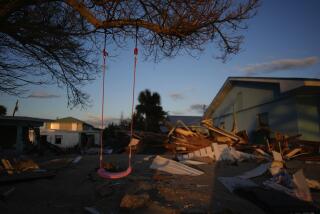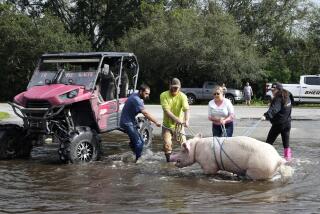Florida Immigrants Revisit Third World : Aftermath: They thought they had left chaos and destruction behind when they came to U.S.
- Share via
HOMESTEAD, Florida — Lots of people who live in the hurricane-torn tip of immigration-rich southern Florida thought they had left behind this kind of physical and economic terrain.
Spotty restoration of phones, electricity and water. Makeshift housing and chaotic traffic. Improvisational medical care. Soldiers in the streets. Charges that government incompetence contributed to the disaster.
It all makes Homestead and its rural surroundings seem more like backwaters in Nicaragua or Belize than an extension of glitzy Miami. After Hurricane Andrew, Homestead seems like another country.
Three weeks after the storm bulldozed the seamless flatlands and swamps here, it is dawning on residents and leaders that Homestead’s return to vitality is no short-term matter. Recovery may take three years, perhaps five. Already shoved out of the nation’s prime-time consciousness by a disastrous storm in the Pacific, Homesteaders have begun to realize that their city and region have been pushed to the lower reaches of development.
“As a community, we became a Third World country overnight,” said Alex Muxo, Homestead’s city manager. “Overnight, we have (had) to deal with the most basic questions of survival.”
The Third World comparison is appropriate for more than just the landscape. Homestead and other small ravaged towns nearby possessed the kind of limited economy common to their near neighbors around the rim of the Caribbean. The dispute over whether to keep Homestead Air Force Base open--President Bush has said that he will rebuild the facility, but the Senate Appropriations Committee last week voted against the plan--highlights the city’s precarious economy.
“We can’t let the disaster dictate the future of the city,” Muxo said. “This is as important to us as the sunshine.”
“This is a terrible thing,” said Carl LaSala, manager of the South Dade Gun and Pawn Shop on U.S. 1 and a retired Air Force employee on the base. “Lots of people depend on this base. This place had my hospital and commissary.”
One might hear the same laments in Panama when periodic debates break out over whether to close American military bases at the Panama Canal as is planned when the canal is turned over to Panama at the end of the century. Such a move would be a blow to Panama, it is said. The Air Force base here is a relatively bigger loss for Homestead, which is a kind of tomato republic with little to fall back on.
Muxo estimated that the base has provided 8,000 jobs and $450 million a year in annual income to the city of 32,000 residents and 70,000 inhabitants in surrounding neighborhoods. Agriculture, also devastated by the storm, has provided $1 billion. Surrounding agricultural lands produce 75% of the country’s winter tomatoes, a crop wiped out this year. It will take two or three years to renew productive growth in damaged lime, avocado and mango groves.
Tourism, the other mainstay of Homestead’s economy, also suffered a serious blow. Most motels are damaged, and travelers have canceled thousands of reservations even in the untouched Florida Keys south of the mainland.
On a disaster tour Saturday, Vice President Dan Quayle repeated Bush’s pledge to rebuild the base. Local leaders insist that, during this era of military cutbacks, the base was never put on a definite list of closures. The 49-year-old facility should be re-established to carry on with its mission of guarding the southern coast against invasion by military foes and drug runners, they say. Some leaders, however, including Gov. Lawton Chiles, talk of converting the runway into a civilian air field at half the cost of rebuilding the base.
“Well, I’d like to stick with Plan A before going on to Plan B,” Muxo said.
Since its founding in 1913, Homestead has been a bridesmaid community--not quite Miami and its hotels and not quite the Keys and their fish. It was once the domain of “Florida crackers,” as descendants of original settlers from Georgia are known, and black laborers who worked their fields. Like much of the rest of South Florida, Homestead is now awash in the tides of immigration that have swept over the region during the last 30 years.
Cubans came to escape Fidel Castro and duplicated fields of exotic fruits and vegetables common to their former home. Yucca, a stringy tuber, became to Homestead what the potato is to Ireland.
Nicaraguans fled the Somoza dictatorship and later the Sandinistas, hungry Haitians fled the Duvalier regime and what has come since to their country. Jamaicans, Mexicans and Salvadorans replaced American-born labor in the fields and packing houses. Along U.S. 1, directions for food outlets and emergency services are given in English, Spanish and Haitian patois.
That many of these places of origin are disaster-prone created both an effect of deja vu and calm for many of the victims of Andrew. Standing in long lines for food is a recent memory for some. “I did this once and can do it again,” said Hector Morales, a plumber who came from food-short Cuba more than a decade ago. “This at least is temporary, I expect.”
Added Alejandro Arguello, a veteran of the 1979 earthquake in Managua, Nicaragua: “Here, I lost the roof of my house. There, I lost my house. But I expect to get the roof back. I never did rebuild my house.”
Troop patrols in the streets and army relief helicopters in the air make the city and surrounding communities appear to be at the center of a coup d’etat . The soldiers are keeping looters from creeping into abandoned houses and have probably kept Homestead from civil war. Houses have been spray painted by their owners with such unwelcoming graffiti as “Looters will be shot” and “Enter and die.”
On Sunday, a resident of a suburban neighborhood exchanged gunfire with a suspected looter, killing him with a shot in the head. It was the first known fatal incident involving a looter. Police said that residents have begun forming night-time vigilante patrols to protect their homes.
“Thank God for the Army,” said Ray McElroy, a shrimp fisherman whose boat sank in the storm and whose mobile home collapsed. “We don’t have much but would have a lot less if they weren’t around.” He was seconded in his appraisal by another piece of spray paint on a nearby house: “This house protected by the 82nd Airborne.”
Damage, even within neighborhoods set close together, is not completely uniform, with some houses near the storm’s center remaining in good shape while others on the margin suffered severe damage. The disparities have led to charges of shoddy construction and the failure of county government to enforce building codes. Lawsuits are being showered on builders of well-to-do neighborhoods that failed to weather the storm--shades of the 1985 Mexico City earthquake whose devastation revealed a long history of building malpractice.
The march of repair has been slow. Water service has been restored, but only 40% of the electricity in the southern towns is back in service. Several neighborhoods of Miami are still without power and communication despite the efforts of both day- and night-shift workers.
Insurance adjusters have flooded in, but repairs to roofs are only just beginning. Thunderstorms, a customary September phenomenon, are adding to the delay--not to mention the discomfort of residents who chose to stay in their battered homes. Insurers and the federal government are distributing checks to the homeless and displaced, but rental prices are rising. There is a dispute within local government about whether to permit trailer parks to rise again in the destroyed mobile home parks. A few grocery stores, restaurants and bars have reopened.
Hurricane Andrew’s general pattern of destruction resembles something like that of an earthquake, starting from blemished Miami and traveling south to the epicenter of Homestead along U.S. 1. Starting from the southern neighborhoods of Miami, the damage is limited to fallen trees, scattered shingles and broken windows. At Kendall, a sprawl of suburban houses and screened-in swimming pools, roofs were blown off and entire windows and doors stripped away. The sign on a McDonald’s hamburger stand reads McD*n*ld’s.
In Cutler Ridge further south, walls of shopping centers collapsed and homes were gutted by winds. At Perrine, entire roofs are missing from homes and buildings alike. In Homestead, mobile home parks were flattened, wooden shacks were twisted and shifted off their foundations, roofs were ripped away and hardly a window remains intact. And the Air Force base was flattened. The sign on a Homestead McDonald’s reads *cD***ld**.
The appearance of emergency services also marks the changing degree of destruction. Traveling south from Miami, soup lines and first aid stations appear at Cutler Ridge. Military police manage the traffic in place of red lights. Free-lance repairmen peddle their skills from roadside tents in Perrine. Telephone companies have opened booths where residents can make free local and long-distance calls. In Homestead, tent cities with their paths turned to mud by recent rains have arisen on athletic fields.
Hector Morales, the Cuban immigrant, shrugged when asked about his tenure at one of these emergency facilities.
“When I came from Cuba, I was put in a tent city for a while. It’s my specialty,” he said.
More to Read
Sign up for Essential California
The most important California stories and recommendations in your inbox every morning.
You may occasionally receive promotional content from the Los Angeles Times.










